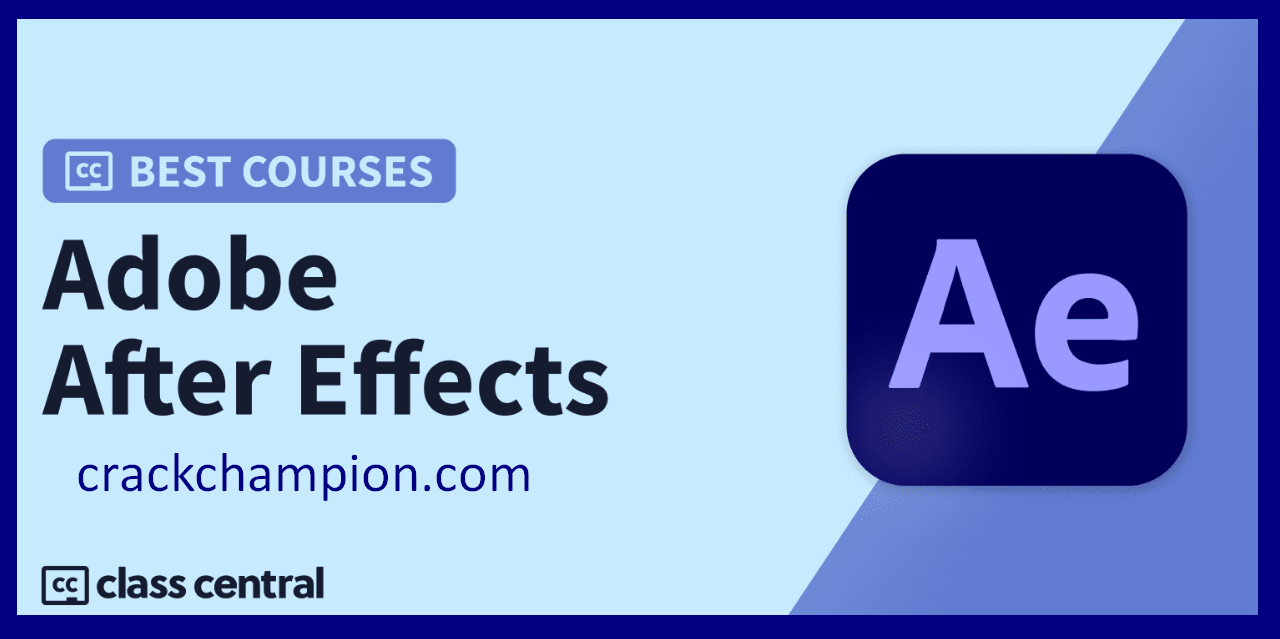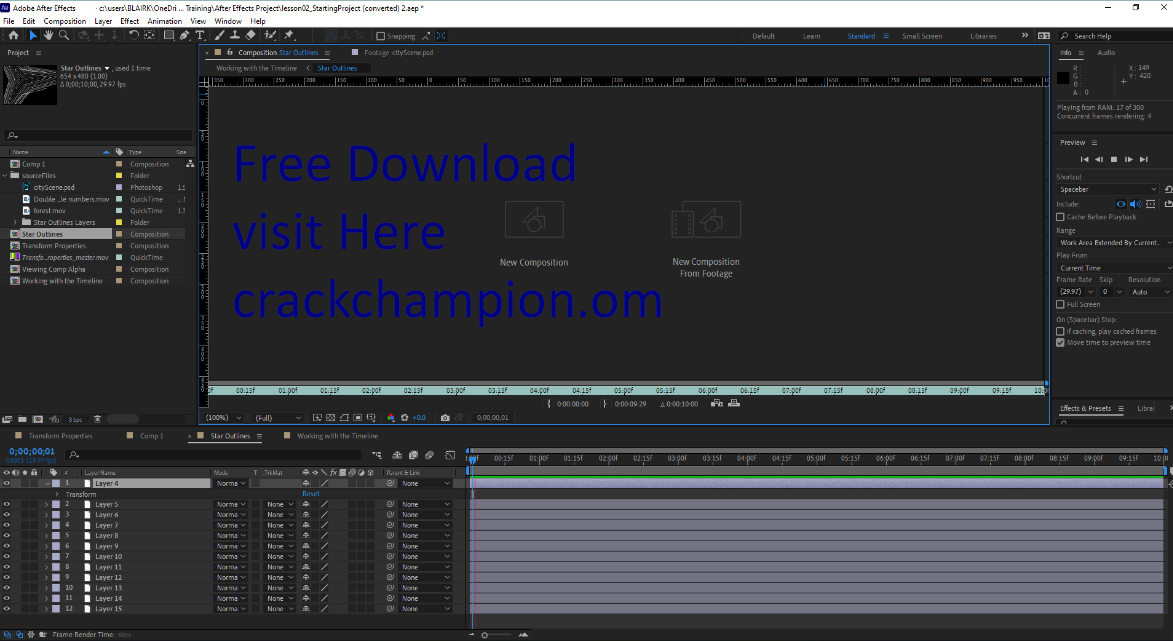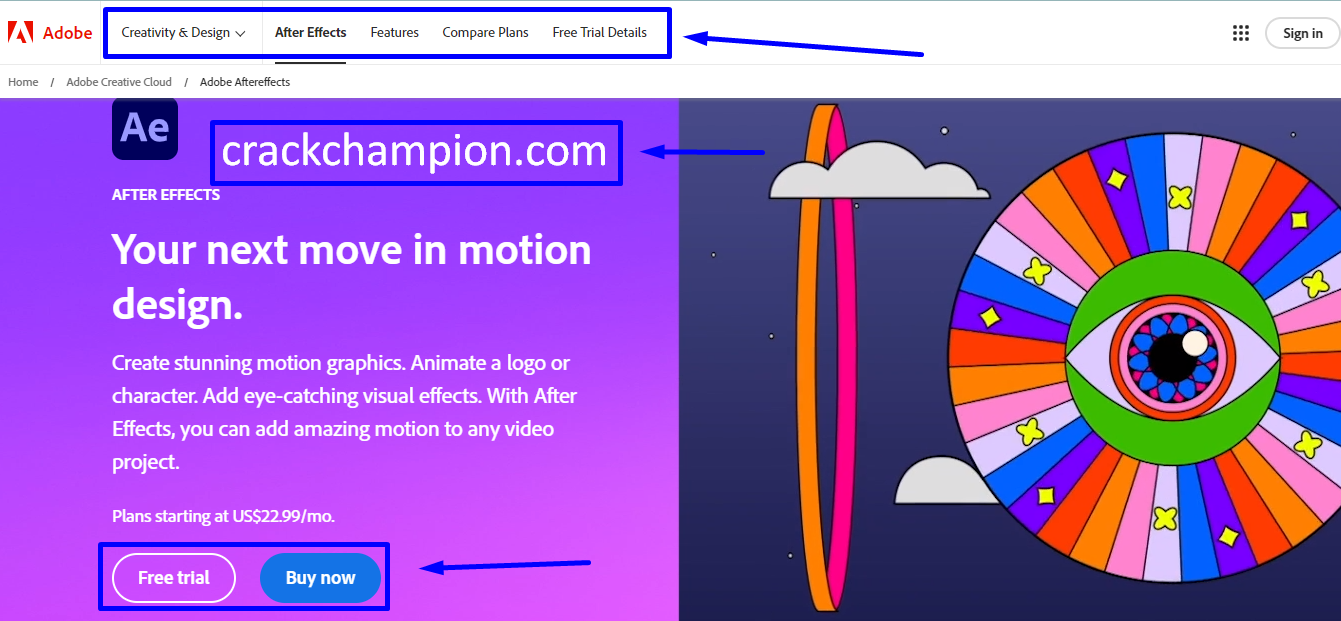Adobe After Effects CC 24.4 Crack + Reddit For Window 10:
Adobe After Effects CC 24.4 Crack is a strong programming application eminent for its flexibility in making movement illustrations and enhanced visualizations. Also, Created by Adobe Inc., it has turned into a staple instrument for video editors, illustrators, and fashioners the same, offering a hearty stage to rejuvenate minds. With its broad cluster of elements, After Effects also empowers clients to create, quicken, and composite media in 2D and 3D space with accuracy. Whether improving video projects with shocking special visualizations, making dynamic text movements, or consistently coordinating CGI components, After Effects also remains a foundation in the domain of computerized imagination and after creation. Its also easy-to-understand interface combined with an immense library of modules and presets engages both old pros and hopeful craftsmen to push the limits of visual narrating.

One of the champion highlights of Adobe After Effects License Key also lies in its capacity to make complex livelinesss and effects through a layer-based compositing approach. This strategy also permits clients to stack various layers of content, each with its properties and changes, to assemble complex scenes and consistent synthesis. Also, its high-level keyframe activity apparatuses give exact command over movement ways, timing, and facilitating, working with the formation of liquid livelinesss that charms crowds. Whether quickening text, controlling film, or planning elaborate movement illustrations, After Effects, also offers unmatched adaptability and artistic liberty, making it essential in businesses going from film and TV to publicizing and virtual entertainment content creation.
Adobe After Effects CC 24.4 Crack With Serial Full Details Here:
Past its movement ability, Adobe After Effects Torrent Free also succeeds in its mix capacities with other Adobe Imaginative Cloud applications. Consistent work processes between After Effects and projects like Adobe Debut Master, Photoshop, and Artist empower proficient venture cooperation and smooth out after-creation processes. This reconciliation upgrades efficiency as well as guarantees a strong imaginative work process where resources and organizations can be effectively moved and controlled across various stages. This interoperability highlights After Effects’ job as a foundation in the sight and sound creation pipeline, where it works with a consistent mix of special visualizations, movements, and designs into the firm, clean results.
Adobe After Effects Keygen also remains a foundation in the domain of computerized content creation, enabling clients to change thoughts into convincing visual stories. Whether used to improve video creations with shocking effects, make multifaceted movement designs, or consistently incorporate CGI components. Additionally, After Effects offers unrivaled adaptability and inventive potential. Its strong list of capabilities, natural point of interaction, and consistent reconciliation with other Adobe applications make it a fundamental apparatus for experts across different innovative enterprises. As innovation and inventiveness keep on developing, Adobe After Effects stays at the very front, driving advancement and setting the norm for enhanced visualizations and movement design programming.
History and Development of Adobe After Effects CC 24.4
Adobe After Effects, also often alluded to just as After Effects, is a computerized special visualizations, movement illustrations, and compositing application created by Adobe Inc. It has also turned into a foundation device in the after-creation process for film, TV, and computerized content creation.
Early Beginnings
After Effects was also initially made by the Organization of Science and Craftsmanship (CoSA) in 1993. The pioneers, David Herbstman, David Simons, Daniel Wilk, and Mitchell Hashimoto, fostered the software basically for the Mac stage. The main variant of After Effects, known as Adaptation 1.0, was delivered in January 1993. This early adaptation gave essential compositing and movement design abilities. It also makes way for its future advancement.
Acquisition by Adobe
In 1994, Adobe obtained CoSA and with it, the privileges to After Effects. Adobe’s acquisition denoted a defining moment in After Effects’ history, as it carried significant assets and development skills to the software. Under Adobe’s stewardship, After Effects developed quickly, incorporating further developed includes and expanding its client base.
Most Important Key Features of Adobe After Effects CC 24.4:
- Motion Graphics and Visual Effects: Create stunning motion graphics and visual effects for film, TV, video, and web projects.
- Compositing: Combine also elements from multiple sources, including 2D and 3D layers, to create complex visuals.
- Animation Tools: Extensive also tools for keyframing, expressions, and animation presets to bring designs to life.
- Effects and Presets: Wide range of built-in effects, plugins, and presets for enhancing visuals and creating unique looks.
- 3D Rendering: Integrated 3D pipeline with Cinema 4D Lite for creating and rendering 3D content directly within After Effects.
- Masking and Rotoscoping: It also precise control over masking and rotoscoping for isolating and manipulating specific parts of a composition.
- Dynamic Link with Adobe Software: Seamless integration with other Adobe applications like Photoshop, Illustrator, and Premiere Pro.
- Responsive Design: Design responsive motion graphics that automatically adjust to changes in duration or aspect ratio.
- Collaboration and Workflow: Collaboration features include project sharing, version history, and integration with Adobe Team Projects.
- Expression Controls: Advanced scripting capabilities with expressions for automating repetitive tasks and creating complex animations.
What’s New In Adobe After Effects CC 24.4 Latest Version?
- Multi-frame rendering: Besides that, Enhances also a performance by distributing rendering tasks across multiple CPU cores.
- Real-time playback: Also, Improved playback performance with GPU acceleration, enabling smoother previewing of complex compositions.
- Advanced puppet tool: Besides that, Upgraded puppet engine for more precise control over deformations and animations.
- Selective color grading: Introduces Lumetri Color effect for targeted color adjustments within compositions.
- Enhanced 3D pipeline: Streamlined workflow with Cinema 4D Lite R25 integration for seamless 3D rendering and animation.
- Improved expressions: Additional JavaScript expressions and performance optimizations for complex animations.
- Vector graphics improvements: Enhanced SVG and Illustrator file import capabilities for vector graphic animations.
- Text styling and animation: Expanded text styling options and animation presets for more dynamic typography effects.
- Collaboration tools: Also, Enhanced integration with Adobe Creative Cloud for smoother collaboration on projects.
- Workflow refinements: It also user interface updates and workflow enhancements for faster and more intuitive editing and animation.
Adobe After Effects CC 24.4: User Interface and Workflow
User Interface Overview:
Adobe After Effects also offers a thorough connection point intended for making movement illustrations, enhanced visualizations, and livelinesss. Here is a breakdown of its principal parts:
Menu Bar and Toolbars:
- The menu bar at the top gives admittance to recording activities, altering devices, and different settings.
- Toolbars house fundamental devices for making and controlling layers, shapes, and effects.
Project Panel:
- Situated on the left side, the venture panel puts together all assets (film, pictures, sound) imported for use in compositions.
Composition Panel:
In the middle, the synthesis panel shows the ongoing piece being altered. Clients also can review activities and effects here.
Timeline Panel:
- Beneath the creation panel, the course of events shows layers and keyframes over the long run. Clients can invigorate and orchestrate layers here.
Preview Panel:
- To one side of the course of events, the see panel shows continuous sneak peeks of compositions with playback controls.
Effects and Presets Panel:
- It also permits clients to apply and modify different effects, changes and presets to layers within compositions.
Layer Panel:
- Offers point-by-point command over individual layers within compositions, including properties like position, scale, haziness, and so on.
Render Queue:
- Utilized for managing and exporting delivered compositions. Clients can arrange yield settings and start delivering.
Workflow Overview:
Adobe After Effects also follows an organized workflow for making and altering movements and special visualizations:
Importing Assets:
- Start by bringing in media assets (film, pictures, sound) into the task panel.
Creating Compositions:
- It also creates another structure by characterizing its settings (goal, span, outline rate) and hauling assets into the course of events.
Adding Layers:
- Import extra assets or make new layers straightforwardly within the course of events. Layers can incorporate video, pictures, text, shapes, and change layers.
Applying Effects and Adjustments:
- Utilize the effects and presets panel to apply effects like haze, variety rectification, advances, and so on, to individual layers or change layers.
Animating Layers:
- Use keyframes in the timetable to enliven layer properties (position, scale, turn, mistiness, and so on.). The diagram manager considers exact command over activity bends.
Working with Masks and Mattes:
- Use masks to change the mistiness or state of layers specifically. Mattes can be applied to control the permeability of one layer given another.
Using Expressions and Scripts:
- High-level clients can utilize expressions and scripts to robotize activity and accomplish complex cooperations between layers.
Previewing and Adjusting:
- Persistently see compositions progressively utilizing the review panel. Make adjustments to timing, effects, and liveliness on a case-by-case basis.
Rendering and Exporting:
- Once happy with the piece, add it to the render queue. Arrange yield settings like organization, goal, and pressure. Begin delivering to produce the last result.
Saving and Managing Projects:
- Save projects consistently to keep up with progress. Adobe After Effects upholds forming and cooperation through Adobe Innovative Cloud.
Applications of Adobe After Effects
Adobe After Effects is widely used for creating motion graphics, visual effects, and animations. It’s popular for:
- Motion Graphics: Designing animated titles, logos, and graphics.
- Visual Effects: Adding effects like explosions and CGI to videos.
- Video Enhancement: It also improves videos with complex animations and transitions.
- Compositing: Combining multiple elements into one scene.
- Title Sequences: Creating dynamic intros for films and shows.
- UI Animation: Designing interactive interfaces with animations.
Industries Using Adobe After Effects
After Effects is used in various industries, including:
- Film and Television: For special effects and animations.
- Advertising: Creating engaging ads and promotions.
- Animation Studios: Producing animated content.
- Gaming: Enhancing gaming visuals and trailers.
- Digital Media: Creating content for online platforms.
- Education: Developing instructional videos.
- Architecture: Visualizing designs with animations.
Learning Adobe After Effects CC 24.4:

Official Adobe After Effects Tutorials:
- Adobe also offers plenty of instructional exercises on their site covering different parts of Eventual outcomes, from novice to cutting-edge methods. These instructional exercises are far-reaching and all-around organized, making them ideal for students, everything being equal.
Online Courses:
- Coursera: Stages like Coursera also offer courses instructed by industry experts. Search for courses on movement designs, special visualizations, or explicit Delayed consequences instructional exercises.
- Udemy: There are various Eventual outcomes courses on Udemy covering everything from the fundamentals to cutting-edge methods. It also makes a point to peruse surveys to track down top-notch courses.
- LinkedIn Learning: Previously known as Lynda.com, LinkedIn Learning also offers many instructional exercises on Eventual outcomes, appropriate for fledglings and old pros the same.
YouTube Channels:
- Video instructional exercises on YouTube can also be extraordinarily useful. Channels like “Video Copilot,” “TutVid,” and “Mikey” give top-notch Eventual outcomes instructional exercises covering various themes.
- Look at instructional exercises on unambiguous impacts, activities, or work processes you’re keen on dominating.
Books:
- Books like “Adobe Eventual Outcomes Homeroom in a Book” by Adobe Imaginative Group give bit-by-bit directions and activities to assist you with dominating Delayed consequences.
- “Making Movement Illustrations with Eventual Outcomes” by Chris and Trish Meyer is one more fantastic asset for learning the product.
Community Forums:
- Sites like also Adobe Community and Inventive COW have dynamic forums where clients can get clarification on pressing issues, share tips, and examine procedures connected with Delayed consequences.
- Partaking in these networks can give you significant experiences and assist you with remaining refreshed on the most recent patterns and procedures moving illustrations and enhanced visualizations.
Practice Projects:
- One of the best ways of learning Delayed consequences is by dealing with projects. Begin with straightforward activities and step by step increment the intricacy as you gain certainty.
- Explore different avenues regarding various impacts, changes, and strategies to foster your abilities and style.
System Requirement:
Minimum:
- OS: Windows 10 (64-bit)
- CPU: Intel Core i5 or AMD equivalent
- RAM: 16 GB
- GPU: 2 GB VRAM, NVIDIA GTX 1050 or equivalent
- Storage: 15 GB free space
- Display: 1280×1080 resolution
Recommended:
- OS: Windows 10 (64-bit)
- CPU: Intel Core i7 or AMD Ryzen 7
- RAM: 32 GB
- GPU: 4 GB VRAM, NVIDIA GTX 1660 or better
- Storage: SSD with 30 GB free space
- Display: 1920×1080 resolution
How To Install For PC?
- First, Visit the Adobe Creative Cloud website.
- Second, Click “Download” for the Creative Cloud desktop app.
- Install the Creative Cloud app on your PC.
- Open the Creative Cloud app.
- Sign in with your Adobe ID or create one.
- Go to the “Apps” tab in Creative Cloud.
- Find Adobe After Effects and click “Install.”
- Once installed, open After Effects from the Creative Cloud app or the Start menu.
- Last, Follow the on-screen instructions to activate After Effects. Check for updates in the Creative Cloud app.
Extra Tips
- Learn: Use Adobe’s tutorials to get started.
- Backup: Save your work frequently.
Conclusion
Moreover, Adobe After Effects is also a strong programming device generally perceived for its flexibility in moving illustrations and enhanced visualization creation. Also, Created by Adobe Inc., After Effects empowers clients to plan perplexing livelinesss, compositing, and dynamic illustrations for different media types including films, Network programs, and notices. One of its champion elements is the capacity to flawlessly coordinate with other Adobe Imaginative Cloud applications, working with proficient work processes for experts in the plan and video altering ventures. Its also strong arrangement of instruments takes into consideration exact command over liveliness boundaries, effects, and layer pieces, making it irreplaceable for the two amateurs and old pros looking to accomplish great visual outcomes. Adobe After Effects keeps on developing, consolidating new highlights and upgrades that further set its situation as a main programming arrangement in the domain of computerized special visualizations and liveliness.
Overall, Adobe After Effects also remains a foundation in the toolbox of sight and sound experts. It also offers unrivaled capacities in making dazzling visual substances. It is also a natural connection point, combined with a huge range of elements for liveliness, compositing, and effects, and engages clients to release their innovativeness and rejuvenate inventive thoughts. As innovation progresses and visual requests develop, After Effects stays at the front, adjusting to recent fads and pushing the limits of what is conceivable in computerized liveliness and enhanced visualization creation. Additionally, For anybody hoping to dig into the universe of movement designs or upgrade their video-altering abilities, Adobe After Effects is a fundamental and imaginative decision.
FAQs About After Effects
- What is Adobe After Effects used for?
Adobe After Effects is also a strong software for creating movement illustrations and visual effects in recordings. It also permits clients to apply different effects, animations, and compositing methods to improve video projects.
- What are keyframe animations in After Effects?
Keyframes in After Effects mark the beginning and end points of any layer property change (like position, scale, darkness, and so forth) over the long haul. They empower artists to make smooth changes and complex movement designs by defining the property estimations at various points on schedule.
- How does masking work in Adobe After Effects?
Masking in After Effects involves defining a particular area within a layer where effects, transformations, and changes are applied. It also permits clients to specifically stow away or uncover portions of a layer, make complex composites, and control the visibility of components within a synthesis.
- What is the difference between After Effects and Adobe Premiere Pro?
After Effects and Adobe Premiere Pro fill various needs in video production. After Effects is also used for creating movement illustrations, visual effects, and compositing. Premiere Pro is also intended for editing recordings, assembling cuts, and adding sound, changes, and effects to make a total video project.
- Can After Effects be used for 3D animation?
While After Effects also has restricted capacities for creating 3D substances straightforwardly. It can also integrate with Adobe’s 3D software, for example, Cinema 4D Light (included with After Effects), for further developed 3D animation and modeling. Clients also can import 3D models and render them with After Effects’ underlying 3D camera and lighting highlights.

